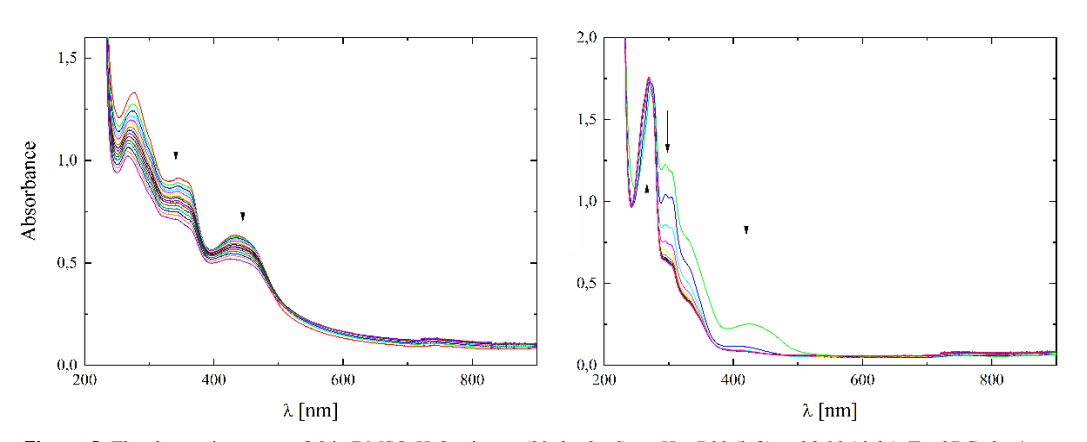Thermal and long period stability of series of V(V), V(IV) and V(III) complex with Schiff base ligands in solid state
DOI:
https://doi.org/10.5604/01.3001.0013.1547Słowa kluczowe:
vanadium, complexes, Schiff base, salicylaldehyde, hydrazide, thermogravimetryAbstrakt
The synthesis and physicochemical properties of three new complexes of vanadium at +5, +4 and +3 oxidation state are described and discussed. The octahedral surrounding of vanadium for V(III) complexes of [V(L1)(HL1)] general formula is filled with two ONO tridentate ligand L, for V(IV) one ONO ligand L, oxido ligand and 1,10-phenanthroline (phen) as a co-ligand are presented in complexes of [VO(L2)(phen)]. For V(V) the complexes of [VO2(L1)(solv)] type were formed. As ligands, the H2L Schiff bases were formed in reaction between 5-hydroxysalcylaldehyde and phenylacetic hydrazide (H2L1) and 3,5-dichlorosalicyaldehyde and 4-hydroxybenzhydrazide (H2L2). The magnetic moment measurements, in 8 year period, show, that V(III) complexes slowly oxidise to V(IV) with preservation of the nonoxido character of the complexes, while V(IV) complexes were found to be stable. The TG and SDTA measurements indicate, that thermal stability depends mainly on the oxidation state of vanadium. The less thermally stable are the V(V) complexes, while V(IV) and V(III) are stable up to ca. 200°C. In solution, at pH 2 (similar to that in human digestion system), again the V(IV) are the most stable, only at pH 7.0 V(III) complexes had higher stability. The most stable, thus best for pharmaceutical use, are V(IV) complexes.
Statystyka pobrań
Bibliografia
Brannick B, Kocak Solomon S. Vanadium in Glucose Metabolism: Past, Present and Future. Journal of Toxicology and Pharmacology. 2017; 1:1-011. Google Scholar
Lyonnet B, Martz, Martin E. L’emploi du vanadium. La Presse Medicale. 1989; 1:191-192. Google Scholar
Hamel FG, Solomon SS, Jespersen AS, Blotcky A, Rack E, Duckworth WC. Alteration of tissue vanadium content in diabetes. Metabolism. 1993; 42:1503–1505. Google Scholar
Smith DM, Pickering RM, Lewith GT. A systematic review of vanadium oral supplements for glycaemic control in type 2 diabetes mellitus. Q.J.Med. 2008; 101:351-358. Google Scholar
Wang J, Yuen VG, McNeill JH, Effects of vanadium on insulin sensitivity and appetite. Metabolism. 2001; 50:667-673. Google Scholar
Barceloux DG. Vanadium. Journal of Toxicology: Clinical Toxicology. 1999; 37:265-278. Google Scholar
Domingo JL, Gomez M. Vanadium compounds for the treatment of human diabetes mellitus: A scientific curiosity? A review of thirty years of research. Food and Chemical Toxicology. 2016; 95:137-141. Google Scholar
Thompson KH, Orvig Ch, Vanadium in diabetes: 100 years from Phase 0 to Phase I. Journal of Inorganic Biochemistry. 2006; 100:1925-1935. Google Scholar
Cusi K, Cukier S, DeFronzo RA, Torres M, Puchulu FM, Redondo JC. Vanadyl Sulfate Improves Hepatic and Muscle Insulin Sensitivity in Type 2 Diabetes. The Journal of Clinical Endocrinology and Metabolism. 2001; 86:1410–1417. Google Scholar
Thompson KH, Lichter J, Lebel C, Scaife MC, McNeill JH, Orvig Ch. Vanadium treatment of type 2 diabetes: A view to the future. Journal of Inorganic Biochemistry. 2009; 103:554-558. Google Scholar
Jakusch, T, Kiss, T. In vitro study of the antidiabetic behawior of vanadium compounds. Coordination Chemistry Reviews. 2017; 351: p. 118-126. Google Scholar
McNeill JH, Yuen VG, Hoveyda HR, Orvig C. Bis(maltolato) oxovanadium(IV) is a potent insulin mimic. Journal of Medicinal Chemistry. 1992; 35:1489–1491. Google Scholar
Peters KG, Davis MG, Howard BW, Pokross M, Rastogi V, Diven C, Greis KD, Eby-Wilkens E, Maier M, Evdokimov A, Soper S, Genbauffe F. Mechanism of insulin sensitization by BMOV (bis maltolato oxo vanadium); unliganded vanadium (VO4) as the active component. Journal of Inorganic Biochemistry. 2003; 96:321-330. Google Scholar
Ki J, Mukherjee A, Rangasamy S, Purushothaman B, Song JM. Insulin-mimetic and anti-inflammatory potential of avanadyl-Schiff base complex for its application against diabetes. RSC Advances. 2016;6:57530- 57539. Google Scholar
Lofti N, Sheikhshoaei I, Ebrahimipour SY, Krautscheid H. Synthesis, characterization, crystal structure and DFT studies of a cis dioxo-vanadium(V) complex containing a tridentate (NNO) Schiff base ligand. Journal of Molecular Structure. 2017; 1149:432-438. Google Scholar
Gryboś R, Szklarzewicz J, Jurowska A, Hodorowicz M. Properties, structure and stability of V(IV) hydrazide Schiff base ligand complex. Journal of Molecular Structure. 2018;1171:880-887. Google Scholar
Szklarzewicz, J, Jurowska, A, Olszewska, A, Hodorowicz, M, Synthesis, structure and properties of V(III,IV and V) complexes with ONO Schiff bases. Science, Technology and Innovation. 2019; 4(1):37-46. Google Scholar
Jurowska A, Szklarzewicz J, Hodorowicz M, Gryboś R. Synthesis, structure and properties of V(V) monooxido complex with ONO tridentate Schiff base. Science, Technology and Innovation. 2019; 4(1):21-29. Google Scholar

Pobrania
Opublikowane
Jak cytować
Numer
Dział
Licencja
Prawa autorskie (c) 2019 Państwowa Wyższa Szkoła Zawodowa w Tarnowie & Autorzy

Utwór dostępny jest na licencji Creative Commons Uznanie autorstwa – Użycie niekomercyjne 4.0 Międzynarodowe.



